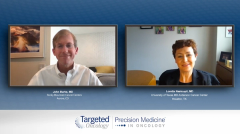
L-MIND Phase 3 Data Presented at ASCO 2021
Loretta Nastoupil, MD, and John Burke, MD, review data from the L-MIND study presented at the American Society of Clinical Oncology (ASCO) 2021 annual meeting for the treatment of relapsed/refractory diffuse large B-cell lymphoma.
Episodes in this series

Loretta Nastoupil, MD: What are your thoughts about some of the data presented at ASH [American Society of Hematology] that it [tafasitamab and lenalidomide] appears to be independent in regard to efficacy whether they’re GCB [germinal center B-cell subtype] or non-GCB? That was intriguing to me.
John Burke, MD: I don’t know that I find it too surprising. I think that’s true pretty much across the board in a lot of these relapsed trials, where these drugs are working in the relapsed setting. I think all of the recent approvals have demonstrated some activity in both the GCB and ACB [activated B-cell subtype]. We know lenalidomide has activity in both, so it’s not too surprising. That’s another example where I would say I wouldn’t hesitate to use it in someone regardless of their subtype.
Loretta Nastoupil, MD: At ASCO [American Society of Clinical Oncology annual meeting] and in the European meetings this year, we saw some data on the First-MIND study. This was utilizing either tafa-len [tafasitamab andlenalidomide] in combination with R-CHOP [rituximab, cyclophosphamide, doxorubicin, vincristine, prednisone], or [tafasitamab] in combination with R-CHOP [rituximab, cyclophosphamide, doxorubicin, vincristine, prednisone]. What are your thoughts about the First-MIND study?
John Burke, MD: I was involved in that study, and this was a phase 1 trial where, as you point out, there were 2 investigational arms and there was a randomization to those 2 arms. These were treatment naïve, newly diagnosed patients with advanced stage DLBCL [diffuse large B-cell lymphoma]. Everyone received R-CHOP [rituximab, cyclophosphamide, doxorubicin, vincristine, prednisone], and then one investigational arm received [tafasitamab] alone, and the other investigational arm received [tafasitamab and lenalidomide], and we reported on 66 patients. At ASCO, we reported on the first view of responses. The overall response was 90% in both arms, and complete remission was 75% in both arms. I think a couple of other key points of First-MIND are that we were able to maintain the dose intensity of R-CHOP [rituximab, cyclophosphamide, doxorubicin, vincristine, prednisone]. We know that other studies of adding targeted agents to R-CHOP [rituximab, cyclophosphamide, doxorubicin, vincristine, prednisone] have suffered if the investigational agent reduces your ability to give R-CHOP [rituximab, cyclophosphamide, doxorubicin, vincristine, prednisone]. We didn’t see that in this study, which was good.
We don’t want to do that when we’re moving forward and in larger phase 3 trials of R-CHOP [rituximab, cyclophosphamide, doxorubicin, vincristine, prednisone]. The one toxicity that was more pronounced in the [tafasitamab and lenalidomide] combination arm was thrombocytopenia. The take-home point is that when using the [tafasitamab and lenalidomide] combination with R-CHOP [rituximab, cyclophosphamide, doxorubicin, vincristine, prednisone], you’re going to see more thrombocytopenia than you do with R-CHOP [rituximab, cyclophosphamide, doxorubicin, vincristine, prednisone] alone or with [tafasitamab] plus R-CHOP [rituximab, cyclophosphamide, doxorubicin, vincristine, prednisone]. Other than that, there were maybe 3 patients who needed platelet transfusions, but most patients did not need that.
The conclusion that we presented is that both arms of the study were very safe. There was not a difference in the efficacy rate, but we did not have enough patients to distinguish an efficacy difference, so that was never a goal of the study. Based on the results of First-MIND, the decision has been made to move on to a randomized phase 3 trial, which is going to compare R-CHOP [rituximab, cyclophosphamide, doxorubicin, vincristine, prednisone] with or without [tafasitamab plus lenalidomide].
It’s going to be the 2-drug investigational arm plus R-CHOP [rituximab, cyclophosphamide, doxorubicin, vincristine, prednisone]. The study is now opening, or open, depending where you are around the world. For community practitioners right now, this is not a regimen I would recommend you go use, nor do I think it would get covered. But this is going to be a large international trial trying to move the field forward. Those are the take-home points from First-MIND.
Loretta, what is your feeling on who would be the ideal patient for [tafasitamab and lenalidomide]?
Loretta Nastoupil, MD: Right now in practice, the patients I’m giving [tafasitamab and lenalidomide] to are going to be those slightly older, frailer patients for whom I don’t have good feelings about RICE [rituximab, ifosfamide, carboplatin, etoposide] or R-DHAP [rituximab, dexamethasone, cytarabine, platinum], and I don’t think that a gemcitabine-based second-line approach is going to be the most effective strategy. These are patients who, if they respond, great, I’m going to follow the protocol that was done in L-MIND. If they lose their response, or fail to respond, then I’m going to potentially pursue still CAR [chimeric antigen receptor] T-cell therapy in that third-line or later space.
Transcript edited for clarity.







































